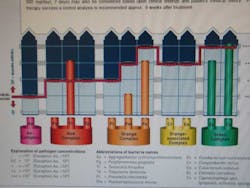Increasing dental case acceptance through the use of salivary diagnostics
A tremendous amount of literature supports the correlations between gingivitis and/or periodontitis and systemic health. Reports and research continue to find correlations between inflammation of the oral cavity and other inflammatory disease processes, especially cardiovascular disease and diabetes. Educating patients about these links and encouraging oral health awareness has always been a challenge. Utilizing salivary testing along with personalized custom periodontal therapy can be a tool to help patients improve not only their oral health but also their overall health.
All too often patients receive a general prophy, which does not provide the level of care needed to treat their specific condition. Recommending scaling and root planing with possible follow-up periodontal surgery to patients based on increased pocketing and radiographic bone loss is a reactionary treatment to a disease process that’s already underway. Preventive therapy or early intervention at the first signs of inflammation can be life changing. Utilizing salivary diagnostics with the overall periodontal/hygiene evaluation is a key way to help patients understand their health and can help provide an objective way to diagnose and communicate their condition and treatment plan.
ADDITIONAL READING |Risk factors revisited
Hain Diagnostics uses a salivary sample from multiple points in the gingiva to determine bacterial counts for the different periodontal bacterial complexes. Using this information can be equivalent to a CBC for primary care doctors. The reports show when the bacterial load is beyond a healthy threshold and thus requires therapy. Therapy can consist of a combination of repetitive oral irrigation with chlorhexidine, scaling and root planing, and a systemic antibiotic cocktail designed to specifically target the bacteria that are most contributory to the inflammation seen in the testing.
Taking a sample is very simple and painless. Paper point type collecting devices are placed in the gingival sulcus for a few seconds, and there is an uptake of fluid onto the strip. The points are collected and sent in a packaged container to the lab. In about eight days, a report is generated along with antibiotic recommendations (Figure 1).
Using the report can also help motivate patients improve their home care as well. Providing a Waterpick as part of the therapy, and encouraging home irrigation can help improve outcomes as opposed to in-office treatment alone.
Knowing that the future of insurance reimbursement will move to diagnostic coding and an outcome-/ results-based model, it is imperative that the industry prepare for that day. Including salivary testing in the diagnostic process along with proper follow-up testing provides an avenue toward evidence-based dentistry. With the continued stress on the insurance industry to reduce costs, be prepared for medical payers to look to dentists to help reduce inflammatory factors for medical conditions, which are much more expensive to treat. While the insurance models are still being developed, it is time to embrace the ability of the dental field to help our patients achieve the improved overall health they deserve.


